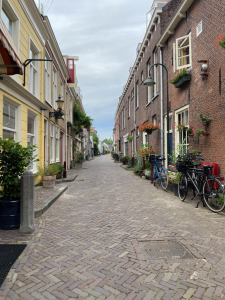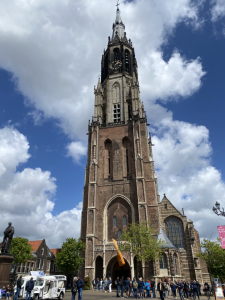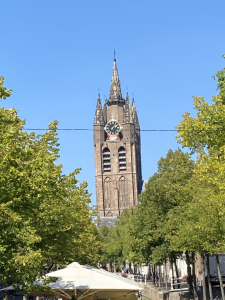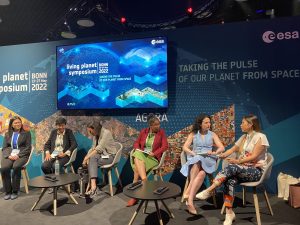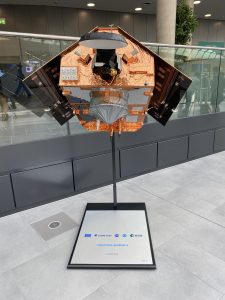Travels: IHE, Deltares, Living Planet Symposium
August 31, 2022
Hi Everyone,
I’m writing to update you all on what I have been up to over the summer months – it’s been busy!
IHE Delft Institute for Water Education
For the last few months I have been living in Delft, Netherlands studying at the IHE Delft Institute for Water Education. First, if you haven’t been to Delft – you must. Like Amsterdam, Delft has a picturesque network of canals and old architecture, but without all the chaos and much less tourism.
Before the Covid-19 pandemic began, I planned to visit IHE for a hydrology course. IHE is a world class research center that focuses on all things water; from wastewater to adaptation measures to water accounting using remote sensing and modelling frameworks. I didn’t quite appreciate the extent of what IHE had to offer until having the amazing opportunity to study here for a few months. I decided to virtually take the hydrology modelling course from IHE in September 2020 and new opportunities opened-up to visit IHE for a longer visit when my travels started again in the winter of 2022.
Except for a few short research trips, the last several months have been spent working at IHE to improve my knowledge surrounding hydrological modelling and specifically, if/how the Soil Water Assessment Tool (SWAT+) can be applied in my research to further understand the influence of small Indian surface irrigation reservoirs on basin-scale water budgets. SWAT+ is a physical model that uses mathematical equations to represent watershed processes – in my case, focusing on hydrology. In order to run it, geospatial land-use data, soil data, elevation data and meteorological data for the watershed are all required, as well as careful calibration of model parameters. Normally, calibration is done by comparing discharge field estimates from gauging station to modelled discharged; however, in ungauged basins, such as the Gundar basin where I study, this data is unavailable. Therefore, in addition to learning how SWAT can be applied, I have been exploring ancillary remote sensing datasets for calibration instead of traditional gauge measurements.
My stay at IHE allowed me to work one-on-one with expert hydrologists (Dr. Shreedhar Maskey and Dr. Ilyas Masih) to help conceptualize the model and to move closer to incorporating tanks within the model. This work will continue over the next few months and will carry on at my future visit to France.
Visiting IHE was a unique experience for me in many ways. Coming from a conventional lab-based research group at UW to IHE was quite eye-opening and refreshing. IHE is UNESCO’s knowledge and training center for water and their approach to education is hands-on and driven largely by practical solutions to the water problems facing society. What immediately struck me at IHE was the diverse skills and cultural backgrounds across the graduate population and the benefit this brings to water related problems.
I first realized this during my second week at IHE when I decided to attend the MSc graduate ceremony – a ceremony that was awe inspiring and made me incredibly hopeful for our water future. The ceremony itself was held in the oldest church in Delft (1246) and it was the first in-person graduation to take place since the Covid-19 pandemic began. The MSc students, water professionals from 60 countries, began their studies during the Covid-19 pandemic, which forced much of their teaching online. The happiness in the church during the entire ceremony as the students, teachers, family, and friends celebrated was overwhelming in the best possible way. Graduate after graduate walked the stage, often holding their national flag or wearing national garments, taking extreme pride in both their accomplishment and the education they can now bring back to their home country. Attending this ceremony and my entire stay at IHE improved my own knowledge surrounding water but it also taught me so much more. It taught me about people and how both collaboration and cooperation are needed to solve the water related challenges we have today.
Coming to IHE has been bittersweet. Prior to arriving in May, my university lab was still not at full capacity and most students were not yet returning. Having a community during your PhD is so important and the COVID-19 pandemic made it challenging to have close-knit lab dynamic. I will miss everyone at IHE so much because for the first time in several years a sense of normalcy returned to everyday working lab life and everyone’s motivation about their research has inspired me to work even harder.
Thank you to everyone that welcomed lunch chats about their research topics and home countries; to my office mates who welcomed me with open arms during my short stay and who hosted me for dinner several times; and to my supervisors and the various other scientists I chatted with to improve my knowledge surrounding water.
Deltares
The Netherlands is a delta area where more than half of the territory and population and
two-thirds of the economic activity are floodprone and at risk of submersion. This is why the Netherlands is a leader in water management and allocates substantial resources to flood protection, water supply and treatment.
While at IHE I reached out to Arjen Haag, who I met through the Round Robin Intercomparison project I mentioned in my last blog. Arjen works at Deltares – an independent, institute for applied research in the field of water, subsurface and infrastructure. He kindly provided me with a tour of the facility which was quite amazing to see. Delates has several state-of-the-art hydro simulators that are used in various experiments to study water quality and the morphology of rivers, lakes and the coast. An example of an experiment would be to test the wave load on a dike and its strength in terms of soil mechanics in an open pit wave simulation.
While at Deltares, I also presented my current research to several remote sensing and hydrology scientists. This provided a fruitful discussion about the challenges of surface water detection from space. Both Gennadii Donchyts and Hessel Winsemius are consultants at Deltares and the leads behind Aqua Monitor. The Deltares Aqua Monitor is the first instrument that operates on a global scale to show where water has been transformed into land and vice-versa with publicly available satellite data. We were able to discuss general challenges for reservoir detection. Gennadii also walked me through some of their existing pipelines, which was valuable to see. Their paper just came out in Nature, which I am looking forward to reading this weekend!
Living Planet Symposium
Every three years the European Space Agency holds the Living Planet Symposium (LPS) and given it was held in Bonn, Germany, I was able to attend. LPS brings together scientists and researchers from all over the world to present and discuss the latest findings on Earth science and advances in Earth observation (EO) technologies. I would say It was the most engaging conference I have attended and after two years of not meeting in person, it felt like exactly what I needed. It felt inspiring to be with a community of scientists all with the same goal – to use EO to contribute to pressing global challenges and from this, implement sustainable new technologies. I focused my week attending technical talks surrounded wetland and reservoir monitoring, agricultural management, and upcoming space missions. I also attended an extremely inspiring panel with amazing women in the field discussing how we can cultivate an inclusive future in remote sensing and EO. The number of people who attended the panel was a testament to how important fostering inclusivity is and how we as a community need to do better. Some takeaways from this panel included the need for women role models in STEM, the need for supporting infrastructure specially for single moms at the working places, embedding geospatial at school level, open dialogue and using open data for empowering women.



